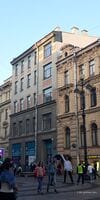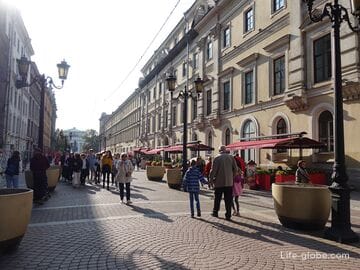Bolshaya Morskaya Street is one of the streets in the historical center of St. Petersburg.
Before the revolution of 1917, Bolshaya Morskaya was one of the most expensive and fashionable streets in the city.
During the history of the street has had several names:
- since 1703-Bolshaya Morskaya Street;
- since 1737-Bolshaya Parlor Street. Unofficially, the street was called " Diamond Street»;
- since 1902-Morskaya Street;
- since 1918-Herzen Street, in honor of the writer and revolutionary Alexander Ivanovich Herzen, who lived on the street in the house number 25 in 1839-1841. From the 2nd half of the 18th century, the plot located in the streets behindSt. Isaac's Square was called Malaya Morskaya Street, and the section running from the Arch of the General Staff to Nevsky Prospekt was called Lugovaya Millionnaya or Malaya Millionnaya Street;
- in 1993, the historical name was returned - Bolshaya Morskaya Street.
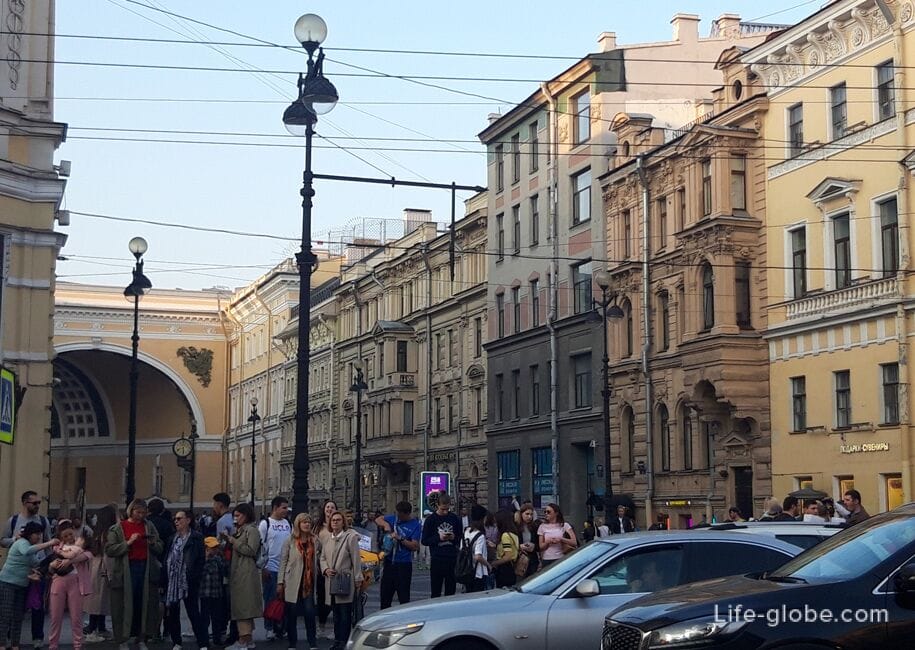
Bolshaya Morskaya Street, as well as the neighboring Malaya Morskaya Street, appeared together with the formation of the city - since 1703. After construction, the street quickly gained popularity and became densely populated. Sailors and employees of the Admiralty settled on the street, which gave the name to the street "Morskaya". The street was built up with wooden one-story houses and daubs with front gardens for the settlement of the middle class. More affluent citizens preferred to settle in the area of Millionnaya Street. Since 1740, stone houses began to appear on Bolshaya Morskaya Street.
Over time, as St. Petersburg developed, Bolshaya Morskaya Street gained popularity and became an increasingly expensive place - bankers, merchants and wealthy people began to settle here; jewelry workshops and shops with expensive goods and luxury items opened. Therefore, the street was secretly called "Diamond".
After the revolution of 1917, some of the buildings on the street were rebuilt.
Today Bolshaya Morskaya Street is a popular thoroughfare in St. Petersburg. Along the street there are historical buildings, shops, cafes and restaurants, as well as accommodation facilities (hotels, apartments)
The length of the street is approximately 1500 meters. It stretches from the Arch of the Main Headquarters (Palace Square) and to the Kryukov Canal (New Holland Island). Part of the street (the end - from the Pochtamtsky Bridge) is an embankment along the Moika River, and part (the beginning of the street) is a pedestrian zone.
It is about the pedestrian part of Bolshaya Morskaya Street that will be discussed in this article.
The pedestrian part occupies a small section at the beginning of Bolshaya Morskaya Street, which stretches from the Arch of the Main Headquarters to Nevsky Prospekt - one of the most visited and beautiful streets of the city. The length of this part of the street is about 120 meters.
View of the pedestrian part of Bolshaya Morskaya Street from Nevsky Prospekt
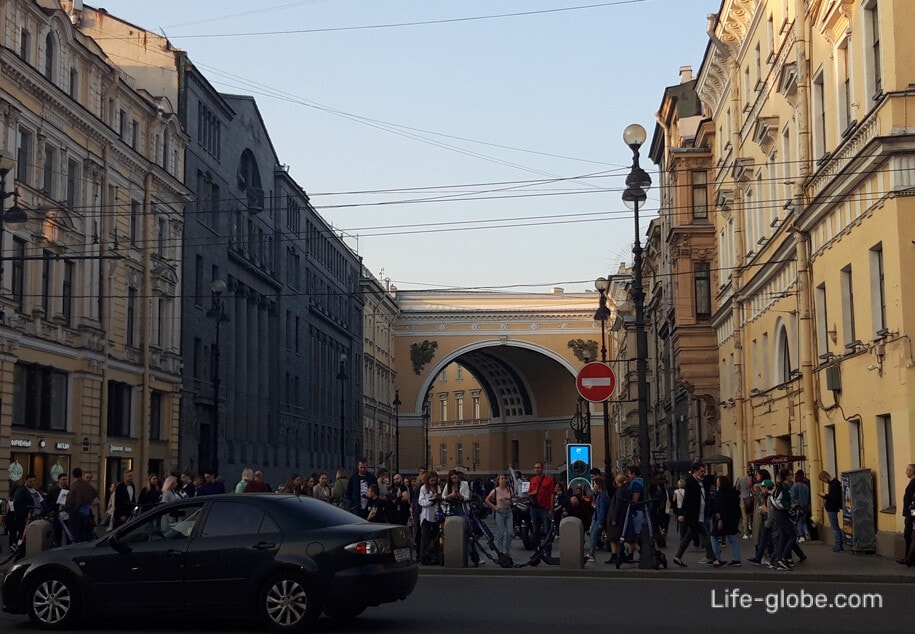
View of the pedestrian part of Bolshaya Morskaya Street from the Arch of the General Staff

The beginning of Bolshaya Morskaya Street is marked by the Arch of the Main Headquarters, which leads to Palace Square.
The arch is a separate symbolic architectural object and the most striking part of the architectural complex of the General Staff. It was built in 1826 as a monument dedicated to the Patriotic War of 1812. The architect was Karl Rossi.
On the side of Bolshaya Morskaya Street, the arch is decorated with the "Mendeleev Clock", which is also called the arch of the General Staff clock. The clock was mounted on a decorative bracket on the wall of the arch in 1905 with the participation of the scientist D. I. Mendeleev.
The watch has a round double-sided dial with the inscription "Main Chamber of Weights and Measures. The exact time" ("The main Chamber of the mѣr and vѣsov. Exact time"). The diameter of the dials is 2 meters. The case is decorated with bronze. Learn more about the General Staff Arch…
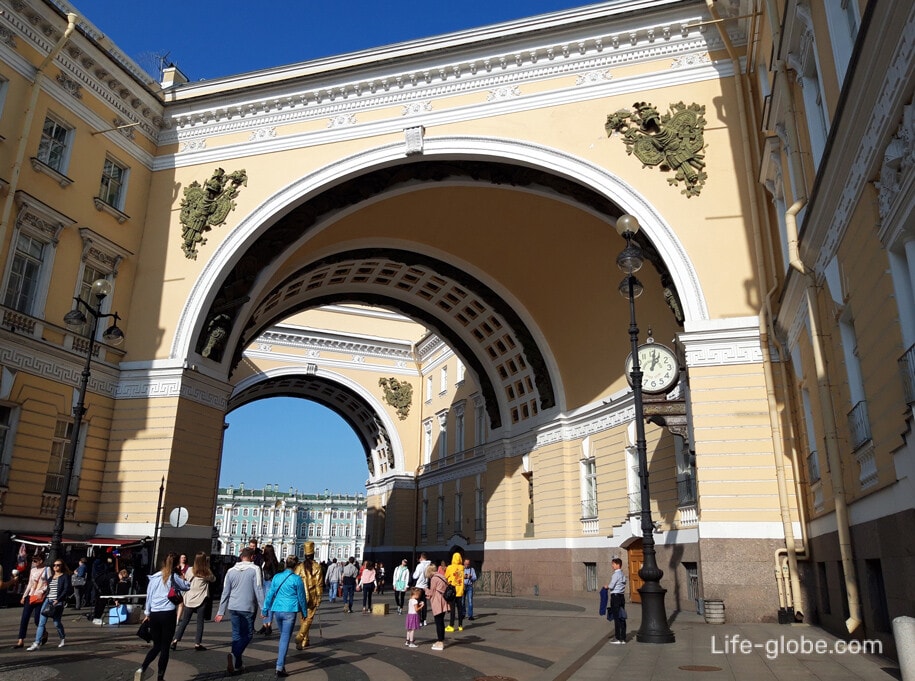
On the western side of the arch, at number 1 on Bolshaya Morskaya Street, stands the facade of the General Staff building, made in the classical style.
In 1934, a cafe was opened here, where for the first time in the city they began to sell the drink "cola".
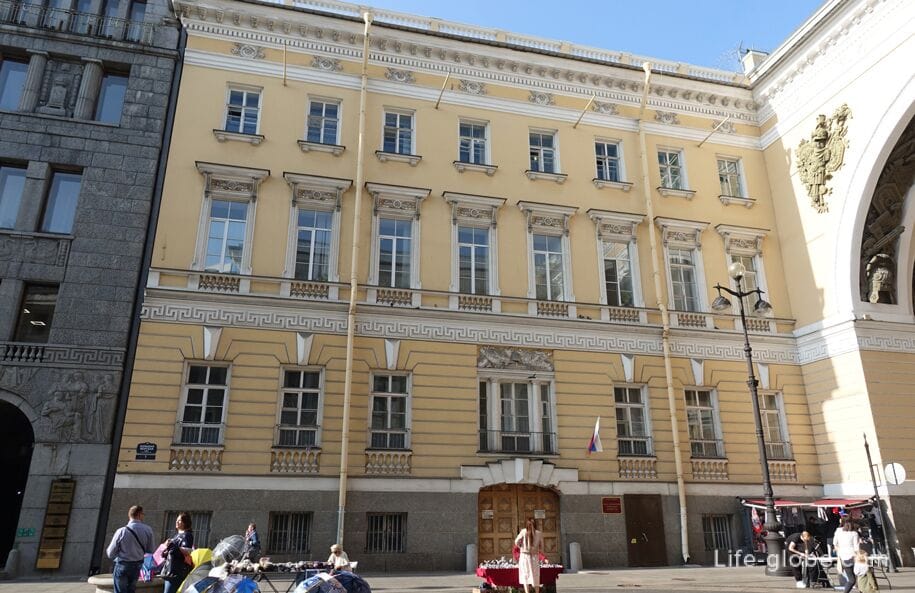
Opposite the building at number 1, there is another facade of the General Staff building (number 2-the eastern facade), also having a classicist style.
This part of the General Staff building was transferred to the State Hermitage Museum and houses the Hermitage's art collections - paintings from the 19th and 20th centuries, mainly Impressionist and post-Impressionist, as well as sculptures, halls in memory of Karl Faberge, the Guard Museum and the exhibition "Ministry of Foreign Affairs of Russia". Read more about the State Hermitage Museum…
Further along the even side of Bolshaya Morskaya Street there are historical buildings with different facades.
In the house at number 6 from 1931 until his arrest on the night of January 2 to 3, 1935, the religious scholar, folklorist and ethnographer Nikolai Mikhailovich Matorin, director of the Museum of Anthropology and Ethnography, lived in apartment number 3. Peter the Great, Institute of Ethnology and Anthropology, one of the founders of the Museum of Religion and Atheism.
Today, this house houses, among other things, a wax museum, which presents figures made of wax and silicone: characters from popular films, historical figures, politicians, actors and artists, Guinness World Records record holders and anomalies of the human body. In addition, the museum has a separate room with an erotic exhibition. Museum website: eto-interesno.
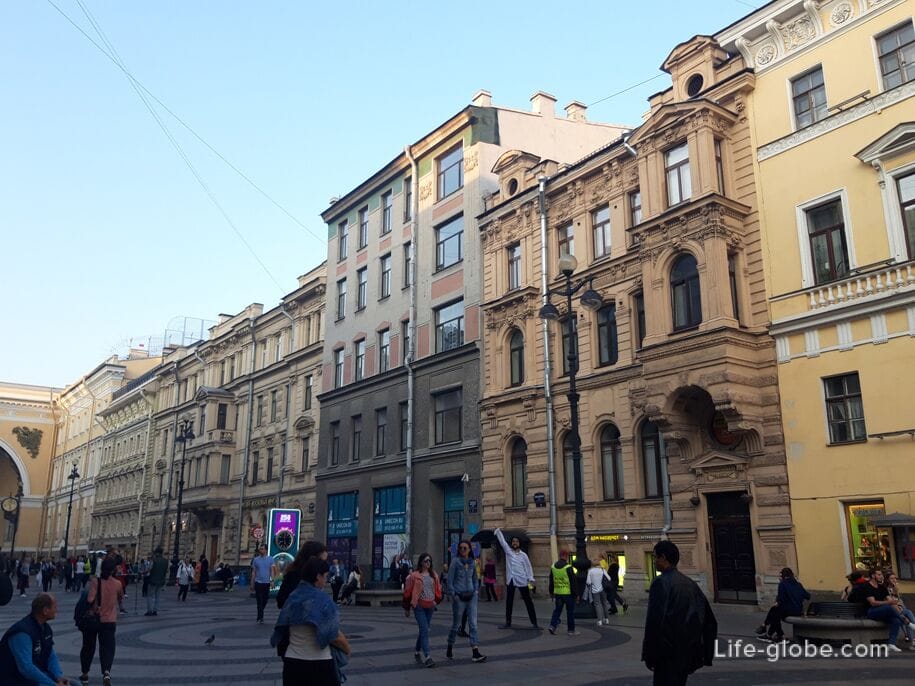
The corner building located at 12 Bolshaya Morskaya Street / 18 Nevsky Prospekt is the I. G. Neumann House, also known as the K. B. Kotomin House (after the names of the owners).
The building stretches along Nevsky Prospekt for a whole block-to the embankment of the Moika River (house 57).
The two-story stone house was built in 1741 by the architect Mikhail Grigoryevich Zemtsov for the tailor I. G. Neumann. In 1806, the house was bought by the merchant K. B. Kotomin, who radically rebuilt the house according to the project of the architect Vasily Petrovich Stasov - the building acquired the features of classicism. It was used as an apartment building.
Since the 19th century, the building has housed: a pastry shop, a French restaurant. In Soviet times, on the first floor there was an antique and second-hand book store-salon "Staraya Kniga".
Today, the building has four floors, is made in the style of high classicism and is divided into two main tiers. The lower tier is decorated with four-column loggias on the sides of the main facade.
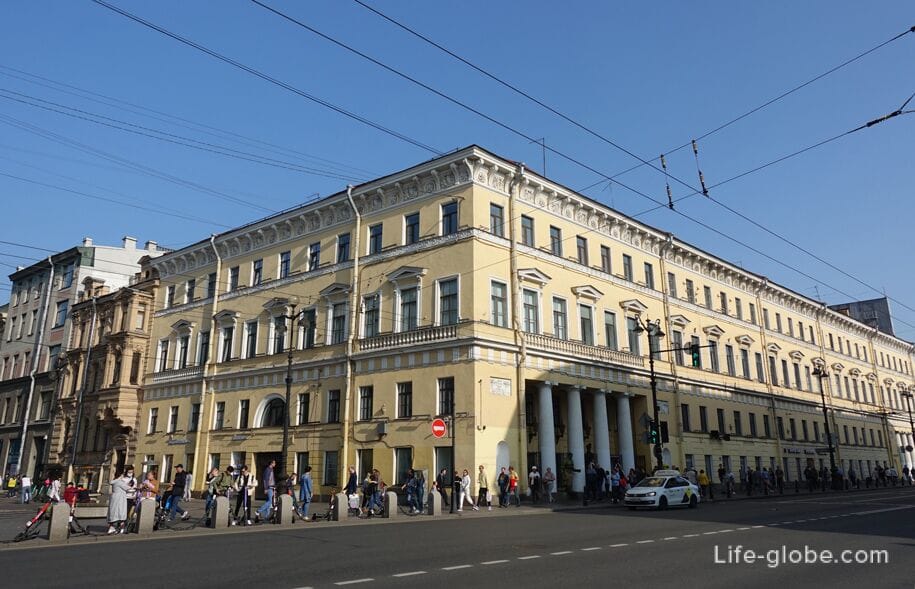
On the odd side of Bolshaya Morskaya Street, a dense rad also stands historical buildings.
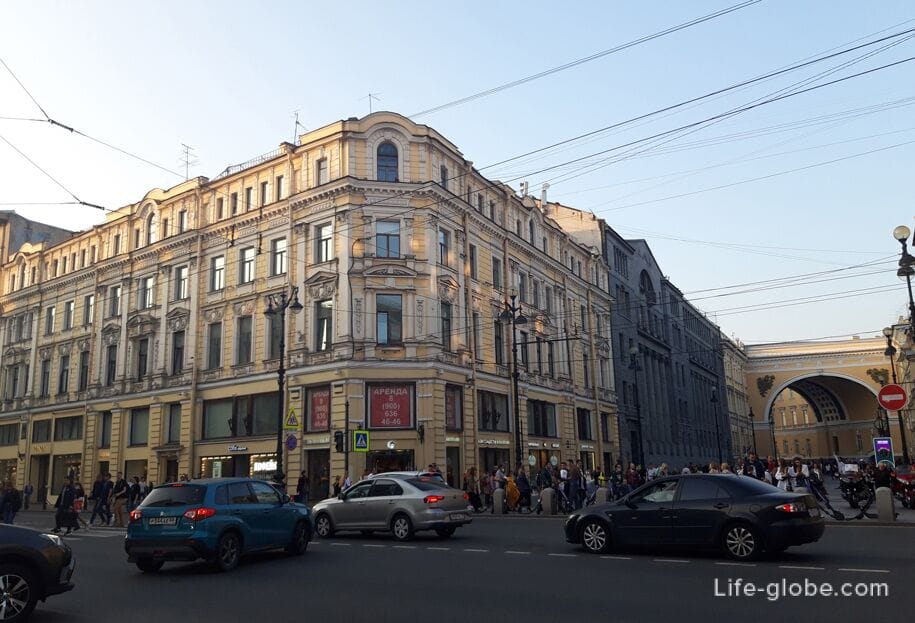
Under numbers 3 and 5 is the former building of the Azov-Don Commercial Bank - one of the largest joint-stock commercial banks of the Russian Empire.
Years of construction-1907-1913 (on the site of two other buildings), architect-Fyodor Ivanovich Lidval.
After 1917, commercial banks were liquidated. In 1920-1930, the building housed the Leningrad Regional office of Torgbank, a savings bank, institutions of the non-ferrous metals industry, etc.
Subsequently, the building was restored and the interior was redeveloped.
Thanks to the rich gray color, the building has a monumental appearance. It is decorated with columns with architectural capitals and ornaments.
Today, the building houses, among other things, the entertainment center "Smile Park" with the giant's house, the museum of illusions, the house upside down, etc.Website of the entertainment center: smile-park.

The corner building located at the address: Bolshaya Morskaya Street 7 / Nevsky Prospekt 16 is the house of L. Ya. Ovtsyn (S. M. Tedeski).
The first building on this site was built in 1766 according to the standard design of the architect Alexey Vasilyevich Kvasov for Lieutenant General Larion (Illarion) Yakovlevich Ovtsyn.
At the beginning of the 19th century, the house was rebuilt. In 1832, it was remodeled by the architect P. P. Jaco.
In the second half of the 1870s, Stanislav Mikhailovich Tedeski, a merchant of the 1st guild, became the owner of the building. For him, in 1880-1881, the house was rebuilt by the architect Ludwig Frantzevich Sperer: the building had a fifth floor, and the facades were decorated in the eclectic style, on the facades there were caduceae-the rods of Mercury, reminding that the building belonged to a merchant; the first two floors were opened with wide showcases.
Subsequently, the owners of the house changed, the premises were rented out to citizens for living and for commerce.
In 1905, for the trading house "M. and I. Mandl", the two lower floors were rebuilt by the architect Grigory Ippolitovich Lyutsedarsky: the shape of the storefronts was changed, the retail premises were updated, and the facade of the building acquired elements of the Art Nouveau style.
In 1917, the house was nationalized and the building housed various institutions.
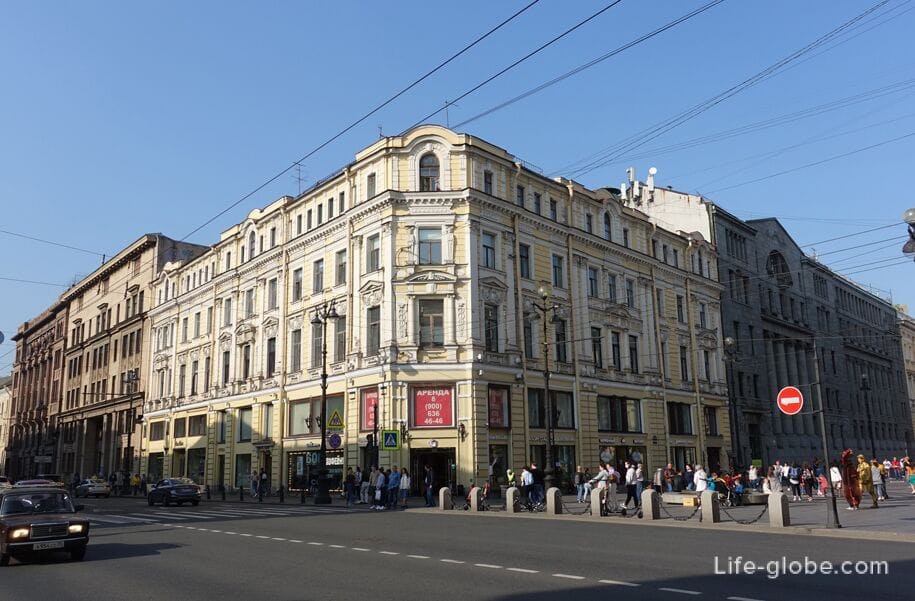
Where to stay near Bolshaya Morskaya Street
Sky Hotel on Nevsky features a shared kitchen, free Wi-Fi and family rooms.
Guests can enjoy city views from the rooms.
Each room here will provide you with a flat-screen cable TV, a refrigerator and a coffee/tea maker.Featuring a shower, the private bathroom also comes with a hairdryer and free toiletries. Link to the hotel
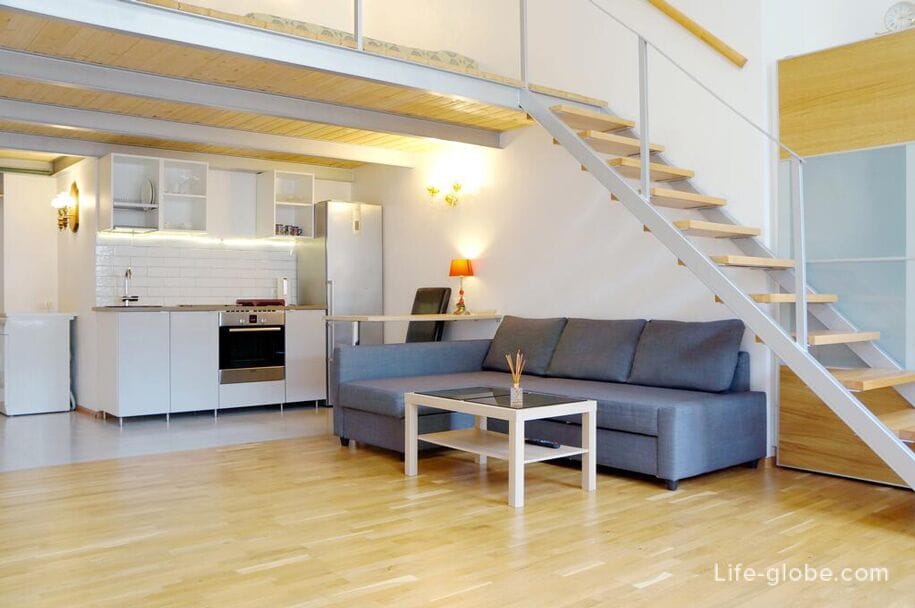
Exclusive living City Centre - Sleeps 20 apartment features a bedroom, an equipped kitchen, heating and air conditioning. Link to the apartment

All accommodation facilities in St. Petersburg, including in the city center and near Bolshaya Morskaya Street, can be viewed and booked here




